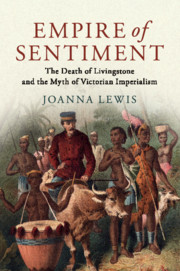Book contents
- Frontmatter
- Dedication
- Contents
- List of Figures
- List of Maps
- Acknowledgements
- Prologue: The Pathetic Death of Bwana Ingeleshi
- Introduction
- 1 ‘A Parliament of Philanthropy’: The Fight to Bury Livingstone
- 2 Laying to Rest a Victorian Myth: The ‘Lost Heart of the Nation’, Victorian Sentimentality & the Rebirth of Moral Imperialism
- 3 A Perfect Savagery: The Livingstone Martyrs & the Tree of Death on Africa's ‘Highway to Hell’
- 4 The Graveyard of Ambition: Missionary Wars, Bachelor Colonialism & White Memorials, Chitambo, 1900– 1913
- 5 White Settlers, Frontier Chic & Colonial Racism: How Livingstone's Three Cs Fell Apart
- 6 ‘The Hearts of Good Men’: 1973, the One- Party State & the Struggle against Apartheid
- 7 ‘Chains of Remembrance’: Livingstone, Sentimental Imperialism & Britain's Africa Conversation, 1913– 2013
- Conclusion
- Epilogue: The Testimony of Pastor Manduli
- Index
3 - A Perfect Savagery: The Livingstone Martyrs & the Tree of Death on Africa's ‘Highway to Hell’
Published online by Cambridge University Press: 06 January 2018
- Frontmatter
- Dedication
- Contents
- List of Figures
- List of Maps
- Acknowledgements
- Prologue: The Pathetic Death of Bwana Ingeleshi
- Introduction
- 1 ‘A Parliament of Philanthropy’: The Fight to Bury Livingstone
- 2 Laying to Rest a Victorian Myth: The ‘Lost Heart of the Nation’, Victorian Sentimentality & the Rebirth of Moral Imperialism
- 3 A Perfect Savagery: The Livingstone Martyrs & the Tree of Death on Africa's ‘Highway to Hell’
- 4 The Graveyard of Ambition: Missionary Wars, Bachelor Colonialism & White Memorials, Chitambo, 1900– 1913
- 5 White Settlers, Frontier Chic & Colonial Racism: How Livingstone's Three Cs Fell Apart
- 6 ‘The Hearts of Good Men’: 1973, the One- Party State & the Struggle against Apartheid
- 7 ‘Chains of Remembrance’: Livingstone, Sentimental Imperialism & Britain's Africa Conversation, 1913– 2013
- Conclusion
- Epilogue: The Testimony of Pastor Manduli
- Index
Summary
I am in blood
Stepp'd in so far that, should I wade no more,
Returning were as tedious as go o'er
William Shakespeare, MacbethLivingstone's African grave lay undisturbed for nearly twenty years. The remoteness, violence and harsh climate of the region meant that the quest to find the Livingstone grave became one of the last nineteenth-century grand European expeditionary competitions in Africa. Tragedy would run through these attempts, ensuring that this final stage of establishing colonial rule was cloaked in the sentimentality of lost loved ones and doomed youth.
After Chief Chitambo's death in 1874, the local population had to subdivide into two villages. A long-standing feud between the peoples on either side of the Luapula River had often turned ugly, but now raiding parties from the east by armed Bemba intent on capturing slaves caused the villages to be abandoned ten years later. Leaving behind their own sacred sites, the villagers moved closer to the Luapula, building first a small stockade. A new village grew up ten miles away. Chitambo had requested that he be placed alongside Livingstone. Apparently, he was buried on the south side of the mpundu tree; Livingstone to the north (see Figure 3.1). But his descendants who told this story may have decided to invent it in order to seek protection through such a bond in death. (The current Chief Chitambo insists that his predecessor lays buried in a private chiefs’ graveyard.)
One of the first Europeans to reach Livingstone's grave, in 1894, was Edward J. Glave, journalist, explorer and Victorian heart-throb. He published an illustrated account of his journey through central Africa to find ‘the heart’ of Livingstone, in the Victorian epic tradition. But his words would carry an extra emotional appeal. By the time readers followed his pilgrimage, he too had perished, another martyr to the ‘great’ Livingstone cause. Leaving no doubt about his mission, Glave described how ‘the sacred tree has often heard the fierce yell of the man-hunters, and the screams of women and children and wounded men. Livingstone's long prayers for Africa's deliverance have not yet received fair response’. He also observed how the ‘Livingstone tree looks sturdy and healthy’ and appeared ‘likely to last many years’.
- Type
- Chapter
- Information
- Empire of SentimentThe Death of Livingstone and the Myth of Victorian Imperialism, pp. 92 - 126Publisher: Cambridge University PressPrint publication year: 2018



